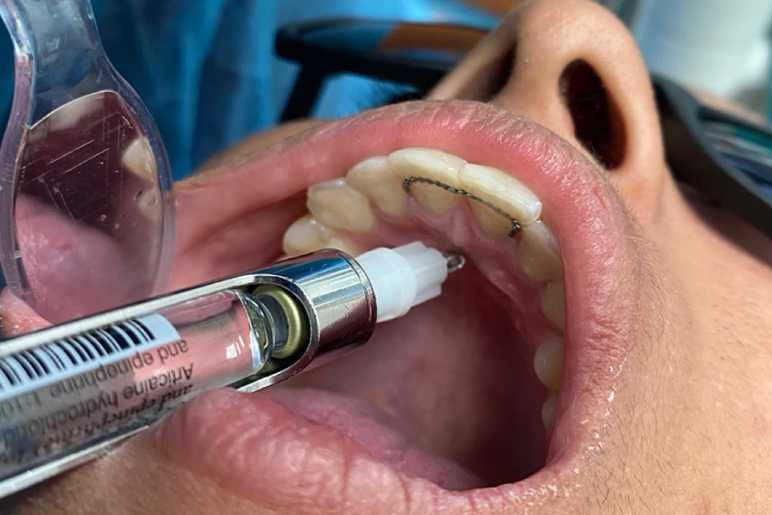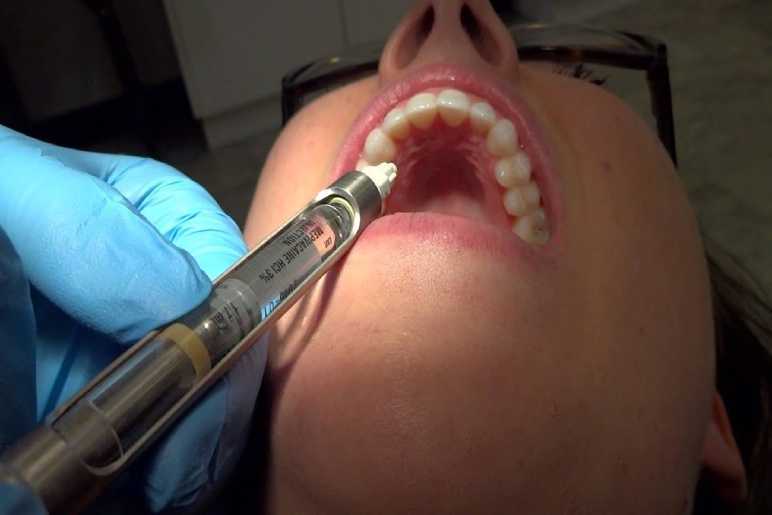When it comes to dental procedures, effective pain management is key to ensuring patient comfort and the success of the treatment. One of the most important techniques used by dentists for this purpose is the nasopalatine nerve block. This anesthetic technique targets the nasopalatine nerve to numb specific areas of the mouth, particularly the palate, during dental procedures. Understanding how this nerve block works, when it is used, and its benefits can help both dental professionals and patients make informed decisions.
In this blog, we will explore the nasopalatine nerve block in detail, its uses in dental practice, and why it’s a preferred method for numbing certain areas of the mouth.
What is the Nasopalatine Nerve?

The nasopalatine nerve is a small nerve that emerges from the sphenopalatine ganglion and runs through the nasal cavity, finally reaching the palate via the incisive foramen. It provides sensory innervation to the anterior part of the hard palate, including the mucosa behind the upper incisors. Because of its location, this nerve plays a crucial role in procedures that involve the upper front teeth or the palatal mucosa in that area.
The nasopalatine nerve is highly sensitive, so any dental work that involves the palate or anterior teeth can cause significant discomfort unless the nerve is properly numbed. This is where the nasopalatine nerve block comes into play.
What is a Nasopalatine Nerve Block?

A nasopalatine nerve block is a form of local anesthesia that targets the nasopalatine nerve, providing numbness to the hard palate and surrounding tissues. This block is particularly useful for procedures involving the maxillary anterior teeth, such as extractions, implants, or any surgical work on the hard palate.
Unlike general anesthesia, which affects the entire body, a nerve block specifically numbs a localized area. For patients undergoing palatal procedures, this technique offers both comfort and pain relief while minimizing the risks associated with more widespread anesthetic methods.
When is a Nasopalatine Nerve Block Used?
A nasopalatine nerve block is commonly used during dental treatments involving:
- Tooth extractions: Particularly the extraction of upper front teeth.
- Implant surgeries: Where implants are placed in the upper jaw or anterior region.
- Periodontal surgery: To address gum diseases and conditions in the palatal area.
- Soft tissue procedures: Including biopsies or lesion removal from the hard palate.
- Orthodontic procedures: That require manipulation of the bone or tissue near the upper front teeth.
By targeting the nasopalatine nerve, this block provides effective numbing of the palate and nearby tissues, ensuring that the patient experiences minimal discomfort during these procedures.
Procedure for Administering a Nasopalatine Nerve Block
Administering a nasopalatine nerve block requires skill and precision, as the nerve lies deep within the palate. Here’s how the procedure typically unfolds:
- Patient Preparation: The dentist or oral surgeon explains the procedure to the patient and ensures they are comfortable. Pre-anesthetic measures, such as applying a topical anesthetic gel to numb the surface, may be used.
- Needle Insertion: A fine-gauge needle is inserted into the mucosa at the incisive foramen, which is located near the upper front teeth. The dentist must be careful to penetrate only the necessary depth to avoid discomfort.
- Anesthetic Injection: Once the needle is in place, the anesthetic solution is injected slowly to allow it to spread evenly along the nasopalatine nerve. This step is done with precision to avoid unnecessary pain or discomfort.
- Numbness Onset: After the injection, it typically takes a few minutes for the anesthetic to take effect, resulting in complete numbness of the anterior hard palate. The dentist can then proceed with the dental procedure.
Benefits of Nasopalatine Nerve Block
The nasopalatine nerve block offers several benefits, making it a preferred choice for both dentists and patients:
1. Targeted Numbing
The nasopalatine nerve block provides localized anesthesia, meaning that only the necessary area is numbed. This allows the dentist to focus on a specific region without causing widespread numbness, which can be uncomfortable for patients.
2. Enhanced Patient Comfort
By numbing the palatal area, patients experience significantly less pain and discomfort during dental procedures. This is especially important for surgeries or treatments involving the sensitive tissues of the palate.
3. Reduced Need for Multiple Injections
Without a nerve block, dentists may need to administer multiple injections to achieve adequate numbness for palatal procedures. The nasopalatine nerve block, however, eliminates the need for additional injections, simplifying the anesthesia process.
4. Safe and Effective
Nerve blocks are generally safe when administered by trained professionals. The risk of side effects or complications is minimal compared to other forms of anesthesia, and the block provides reliable pain relief.
5. Faster Recovery
Since only the targeted area is numbed, patients typically recover sensation more quickly after the procedure. This allows them to return to normal activities sooner without experiencing prolonged numbness in unrelated areas of the mouth.
Risks and Considerations
While the nasopalatine nerve block is generally safe, there are some potential risks and side effects to be aware of:
- Pain or discomfort at the injection site: Some patients may experience mild discomfort during or after the injection.
- Temporary numbness beyond the target area: In rare cases, the anesthetic may spread to nearby tissues, causing temporary numbness in unintended areas.
- Allergic reactions: As with any anesthetic, there is a small risk of allergic reactions. However, this is rare and can be managed by the dental professional.
It’s important to communicate any concerns or medical conditions with your dentist before the procedure to ensure the safest and most effective outcome.
Conclusion
The nasopalatine nerve block is an essential technique in modern dental practice, providing targeted pain relief for procedures involving the hard palate and upper anterior teeth. By numbing the nasopalatine nerve, dentists can perform extractions, surgeries, and other treatments with minimal discomfort to the patient.
For dental professionals looking to expand their knowledge and skills in administering nerve blocks, or for patients seeking comfortable and effective dental treatments, understanding the role of the nasopalatine nerve block is crucial.
At Abdenatlogic, we believe in promoting advanced dental practices that prioritize patient comfort and safety. Stay informed about the latest in dental care by exploring our resources and expert insights on innovative techniques like the nasopalatine nerve block.
Have A Look :-
